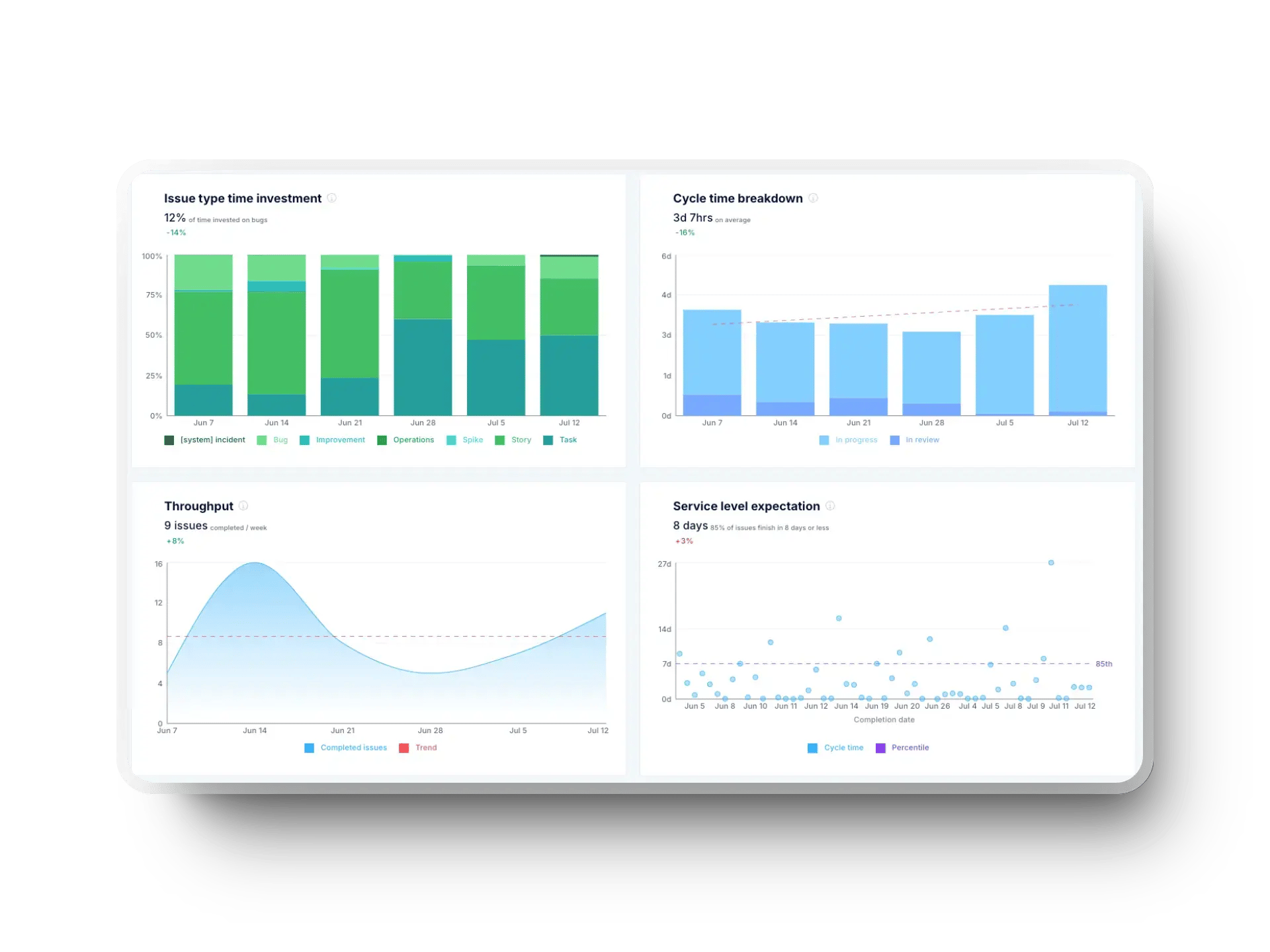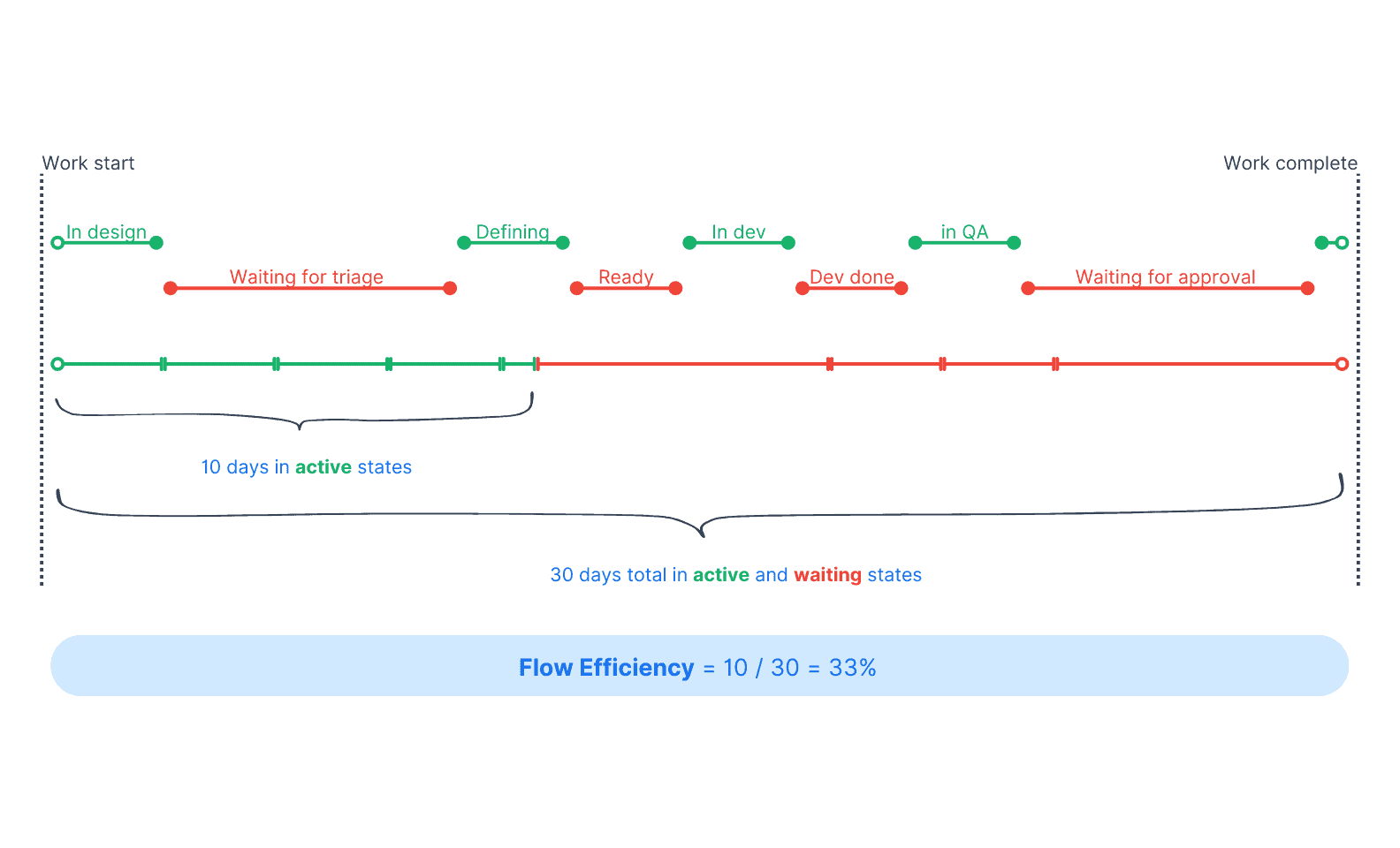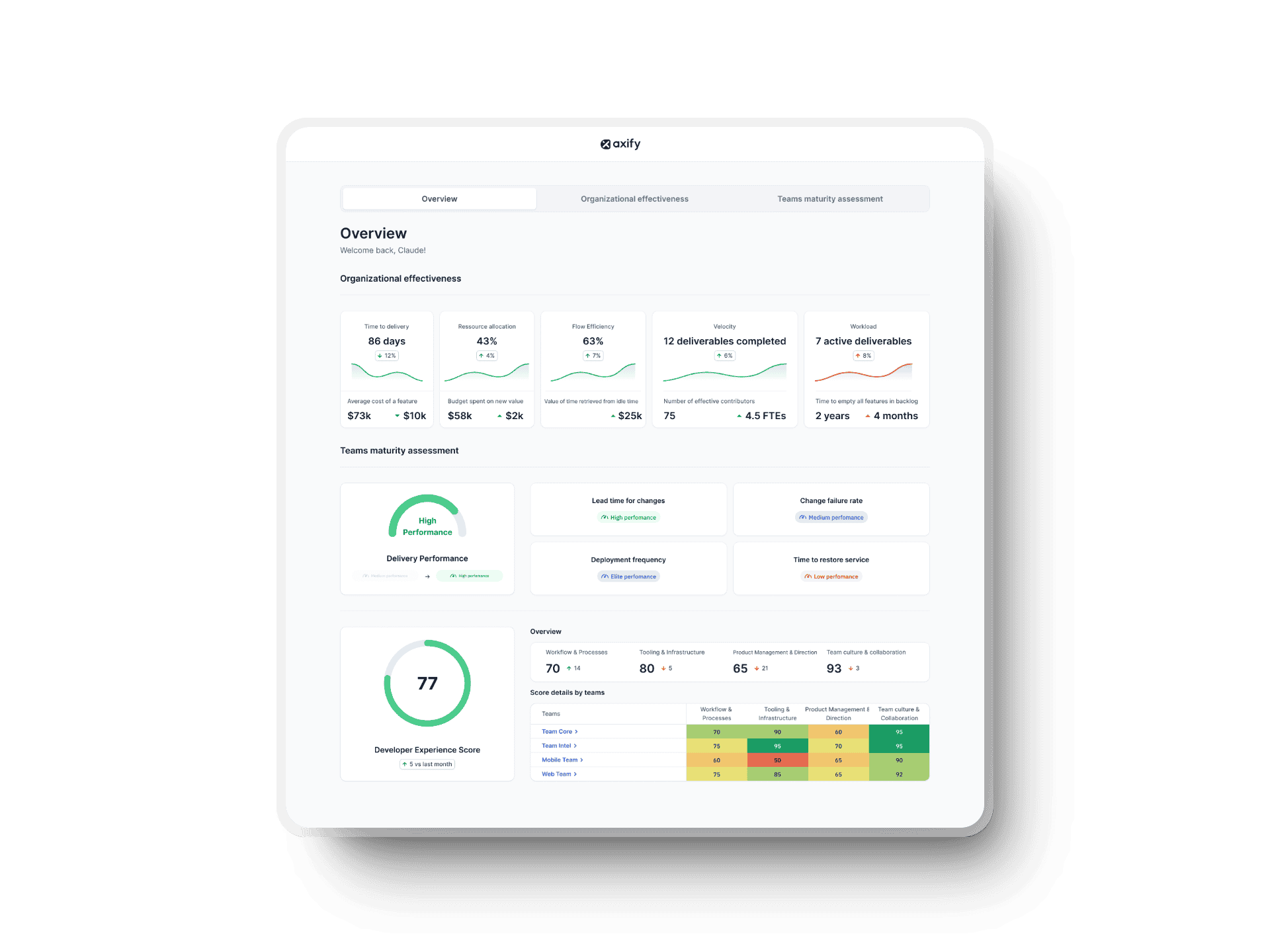If you're seeking alternatives to the Flow Framework, you're in the right place.
While the trademarked flow dashboard provides a solid foundation for tracking flow metrics, it’s not your only option.
Several tools, like Axify, Jira Align, and ServiceNow, offer comparable and arguably even enhanced solutions.
In this article, we'll explore:
- What the Flow Framework is
- Why consider other options
- How these flow framework alternatives stack up
Let’s dive in.
Insider tip: Want a bird’s-eye view of all your metrics in one place? Try Axify now. We help all your teams understand their performance and keep track of morale so they can work better together.
What Is the Flow Framework?
Dr. Mik Kersten introduced the Flow Framework in 2018. It is a methodology developed to help organizations transition from project-based to product-oriented value streams.
You track so-called flow metrics that help you optimize software delivery from idea to deployment. You get valuable insights into bottlenecks, inefficiencies, and delays, so it’s easier for your team to improve the flow of business value and deliver high-quality software faster.
This begs the question:
Why Consider Alternatives?
While the Flow Framework offers a comprehensive methodology, it's worth noting that Planview now holds its trademark. As a result, it is tightly integrated with their proprietary software. This exclusivity can lead to limited flexibility because a framework is, by definition, rigid.
Besides, businesses with unique toolchains or specific needs may find that other software delivery toolchains offer better integration and customization options.
The good news is that flow metrics—the core concept of the Flow Framework—are free for everyone.
These KPIs can be followed and analyzed with other tools.
For example, Axify provides flow metrics tracking, resource allocation, and team health tracking, often at a lower cost and with more adaptable features.
But before we get into Flow Framework alternatives, let’s look at flow metrics and why you should monitor them.
Flow Metrics and Their Benefits
What Are Flow Metrics?
Flow metrics are key indicators that measure how effectively work moves through the software delivery process. Here are the core flow metrics:
- Flow velocity: Flow velocity tracks the number of flow items (such as features, defects, or technical debts) completed over a specific time period. It helps software delivery organizations gauge how quickly their teams are delivering value.
- Flow time: Measures how long flow items take to move from when work begins to delivery, tracking all development stages.
- Flow efficiency: The flow efficiency metric compares the time actively spent working on a flow item versus the time it spends idle. It highlights bottlenecks in the entire value stream that delay development.
- Flow load: The flow load metric tracks the number of flow items in progress at any given time. A high flow load can indicate overburdened teams or bottlenecks, leading to slower delivery and decreased productivity.
- Flow distribution: Flow distribution metrics categorize the flow items by type so you can see where your resources are going and assess your priorities. The point is to align development teams with business outcomes, ensuring the right balance of work.
Why Flow Metrics Matter
Flow metrics give a real-time snapshot of how efficiently a development team operates, pinpointing bottlenecks and areas for improvement. These metrics are essential because they:
- Provide actionable insights about productivity levels to engineering managers and leaders.
- Highlight bottlenecks to identify where flow items get stuck. This could be in the development backlog, during code creation, or in the testing stages. Identifying these blockages helps you adjust workflow logic to keep things moving smoothly.
- Optimize delivery flows so you can allocate effort and resources strategically across different types of work. This will enhance product value streams and, therefore, improve business outcomes.
- Reduce idle time and wasted resources. This leads to higher software quality and faster release cycles.
How Flow Metrics Fit Into Agile and DevOps
In both Agile and DevOps contexts, flow metrics provide the feedback loops necessary for teams to make data-driven decisions and optimize their software delivery toolchain. Here’s how:
-
Agile teams: Flow metrics complement Agile practices by providing insights into how work moves through user stories and sprints. Agile teams can ensure that work is delivered incrementally, aligning with Agile’s goal of continuous improvement. You can also integrate flow metrics into Scrum events, such as daily stand-ups and sprint reviews. The point is to ensure that work progresses as planned and identify impediments.
-
DevOps teams: Flow metrics support DevOps best practices by tracking how efficient your teams’ development lifecycle is. This allows you to identify potential delays and align with DevOps' faster delivery and better collaboration goals.
- Project-to-product mindset: Flow metrics also play a crucial role in the shift from project-based management to product-focused management, as discussed in Mik Kersten's Project to Product. Focusing on flow improves your delivery value stream, which translates into continuous delivery of business value.
Top Alternatives to the Flow Framework
Let’s dive into the section you’re really interested in.
1. Axify
Axify is a comprehensive metrics dashboard that lets you get a bird's eye view of your team’s performance by following the same workflow logic.
Flow Velocity → Throughput
Flow velocity and Throughput in Axify track the number of tasks finished during a specific time period. The key difference here is that Axify’s Throughput offers more flexibility for DevOps teams aiming to increase delivery speed while maintaining a steady workflow. The focus is not just on speed but also on balancing workloads across the delivery value stream.
Flow Time → Cycle Time
Flow time tracks the entire journey of a work item from ideation to completion, including any wait times. This is almost identical to cycle time in Axify, which measures how long a flow item takes to complete from start to finish.

The critical difference is that Axify’s cycle time can also be applied to specific stages within the workflow, offering more granular control over what you monitor. Therefore, you can zoom in on particular bottlenecks within your process.
.webp?width=1584&height=960&name=Axify%20blogue%20header%20(2).webp)
Flow Efficiency → Flow Efficiency
Both Axify and the Flow Framework share this metric. In Axify, flow efficiency measures the ratio of active work time to total cycle time in the overall process. By contrast, this metric measures active vs wait time in the original flow framework. The goal is to see how much time you spend working on flow items compared to waiting stages like code review or approval processes. This helps you find and implement solutions to reduce delays and improve workflow efficiency. As a result, you can deliver high-quality software faster.

Flow Load → WIP (Work in Progress)
Flow load measures the number of flow items in progress at any given time. Axify replaces this with WIP (Work in Progress), which tracks the same concept but focuses more on balancing the number of ongoing tasks to avoid bottlenecks.
%20metric%20in%20Axify%20for%20software%20engineering%20teams.webp?width=1260&height=1134&name=Work%20in%20progress%20(WIP)%20metric%20in%20Axify%20for%20software%20engineering%20teams.webp)
Flow Distribution → Issue Type & Time Investment
Axify doesn’t track flow distribution directly, but it offers a similar metric: Issue Type & Time Investment. This KPI helps you track the types of work your team is focusing on (e.g., feature development vs. bug fixes) and whether there’s an imbalance in how time is allocated across various tasks. Monitoring it helps you prioritize the right tasks to avoid delays in software delivery and get better business outcomes.


2. Jira Align (by Atlassian)
Jira Align offers a comprehensive set of metrics that mirror the Flow Framework's core metrics, focusing on enterprise-level Agile teams and planning. Here's how Jira Align compares:
- Flow velocity → Velocity reporting: Jira Align uses Velocity Reports to track the number of story points completed in each sprint. Thus, its approach is more focused on Agile principles rather than directly tracking flow items. By comparison, flow velocity tracks work items and emphasizes business value.
- Flow time → Lead time: Jira Align tracks lead time, which measures how long it takes from when a task or request is first made until it is fully delivered. Lead time is similar to flow time but with more emphasis on agile teams tracking the progress of sprints and epics. Plus, it includes time spent in the backlog, so it can help you identify any bottlenecks there.
- Flow efficiency → Work efficiency: Work efficiency in Jira Align shows how much time you spend actively working on tasks versus the total time elapsed. Tracking workflow types and delays in Jira helps optimize your work processes and reduce unnecessary idle time.
- Flow load → Team capacity: Jira Align does a good job of tracking team capacity to ensure workload balance, but it focuses heavily on Agile sprints and ensuring teams are not overburdened. This is comparable to flow load but integrates a more detailed Agile perspective regarding sprint planning.
- Flow distribution → Work breakdown: The Work Breakdown feature in Jira allows you to track work across different epics, tasks, and sub-tasks. This is comparable to flow distribution metrics in the Flow Framework but integrates more detailed tracking of how work is divided and where resources are allocated. That means staying focused on high-priority tasks while maintaining a clear view of work distribution.
Pro tip: Axify integrates with Jira, so you can collect this useful information and skyrocket your team’s performance. Axify also integrates with Azure DevOps, GitLab, and GitHub.
3. ServiceNow (Agile Development)
ServiceNow’s Agile Development suite also provides flow metrics alternatives, especially for enterprise software delivery. Its key metrics and features support DevOps teams and agile workflows:
- Flow velocity → Velocity metrics: ServiceNow tracks how many tasks or user stories are completed within a time period, similar to flow velocity. However, ServiceNow primarily emphasizes user stories, making it more focused on Agile processes than the broad business value approach in the Flow Framework.
- Flow time → Time-to-market: ServiceNow’s Time-to-Market metric focuses on the time it takes to bring a customer-facing feature to production. This metric is broader than flow time, which starts when an item is pulled into development. By comparison, Time-to-Market encompasses the overall delivery process, including market-facing steps.
- Flow efficiency → Productivity reports: ServiceNow uses productivity reports to track how efficiently teams work by comparing time spent on value-adding tasks to the total time spent on the project. Like flow efficiency, this metric helps teams identify waste in their processes and streamline workflows for better results in creating code and software delivery toolchains.
- Flow load → Workload balancing: The Workload Balancing feature in ServiceNow helps teams manage tasks across different departments and avoid overload. Like flow load, it allows teams to see whether they are taking on too much work and helps distribute tasks more evenly to maintain steady progress and avoid bottlenecks.
- Flow distribution → Task type tracking: ServiceNow tracks Task Types (e.g., features, bugs, technical debt) to ensure that teams spend their time on the right mix of work. This is comparable to flow distribution metrics but is integrated more closely with resource planning and balancing between urgent tasks and long-term business products.
Besides, ServiceNow has the Flow Designer feature, which uses natural language descriptions to help even non-technical members automate tedious tasks.
Beyond Flow Metrics: Axify’s Additional Features
Axify doesn’t just track metrics indiscriminately. Our platform has many features that combine well to streamline your workflow and improve efficiency.
- Predictive analytics: Software Delivery Forecasting can predict software deployments, showing visual projections of different delivery dates. This allows you to make data-driven decisions on where to allocate resources and adjust priorities.
- Team well-being tracker: Unlike traditional metrics, Axify recognizes that a healthy team is critical for sustained high performance. This feature provides valuable insights into team morale, burnout risk, and overall health. Tracking these variables allows engineering managers to create a positive working environment and retain top talent.
- DORA metrics: Axify also integrates DORA metrics, giving you a complete view of your DevOps performance. Improving this performance translates into more reliable deployments and higher customer satisfaction.
- OKR (Objectives and Key Results) tracking: Axify helps you stay aligned with your continuous improvement goals by setting clear objectives and measurable key results and ensuring your engineering efforts align with organizational goals.
- Value Stream Mapping: Axify’s VSM tool provides detailed visual maps showing the entire software development process and highlights which phases are bottlenecks or consume the most of your team's time.
- Executive dashboard: Axify allows you to translate your engineering results into business impact and financial terms. You get a clear snapshot of the current state and can map out potential improvements. As a result, you can make strategic decisions and justify resource investments to leadership. The visibility offered by the executive dashboard is the first step in driving strategic discussions with leadership, leading to more data-backed decisions that support the company’s growth.

Which Flow Framework Alternative Is Right for You?
In this guide, we reviewed the top 3 alternatives to the Flow Framework. They all have pros and cons, so here’s how to make the right decision.
Choose Based on Features
The world of Flow Framework alternatives is broad. So, first things first: consider your team’s needs. If you focus on streamlining the entire value stream and optimizing flow metrics, choose a metrics dashboard to track performance. On the other hand, a project planning tool would be better if you need to manage large projects with an emphasis on Agile principles and coordination across teams.
Pro tip: Axify offers a smooth and intuitive interface for the whole team – even non-technical members.
Consider ALL Metrics and Integrations
Axify helps you track flow metrics, team performance, and resource allocation and integrates easily with a wide range of tools across the software delivery toolchain.
Similarly, Jira Align tracks Agile metrics and offers excellent integration with code repositories and popular project management tools like Jira Software. ServiceNow, on the other hand, offers workload balancing for teams needing more detailed work distribution management, making it a solid choice for larger enterprises that require extensive cross-department collaboration.
Budget Considerations
Jira Software offers a free version if you have a budget-conscious team or startup. However, free tools have limitations, especially in terms of analytics depth and scalability.
Axify is a paid but affordable solution. We offer a more intuitive interface with advanced features that ultimately save time and money.
Our VSM metrics help justify investments by providing precise financial projections and measurable ROI on process improvements. And we’re constantly adding new functionalities, such as the DevEx improvements feature.
Conclusion: Why Axify Might Be the Better Alternative
While tools like Jira Align and ServiceNow offer comprehensive solutions for tracking flow metrics, Axify stands out as the more complete package.
Axify has solid alternatives to the Flow Framework's core metrics but goes beyond with predictive analytics, team well-being tracking, and value stream mapping to drive continuous improvement.
Book a demo today to discover how Axify can transform your team's efficiency.






.png?width=60&name=About%20Us%20-%20Axify%20(2).png)

